Hospitals invest huge effort in reducing Did Not Attend (DNA) appointments: reminders, administrative calls, SMS systems, community outreach, and redesigned booking pathways. Yet despite all of this, many hospitals still see thousands of missed appointments every month.
But one factor is rarely discussed, and even more rarely measured:
Patients often miss appointments because they can’t find the right room.
For anyone familiar with large, multi-building hospital estates, this isn’t surprising. But until recently, the impact of navigation barriers on DNAs has been undocumented, until a major NHS trust decided to measure it.
A recent trial at University Hospitals of Leicester NHS Trust (UHL), published by NHS England’s Future Connectivity Programme, highlights just how significant this issue is and how digital wayfinding can start to close the gap.
Full trial results available here
Navigational Challenges Are a Hidden Contributor to DNA Rates
UHL treats over one million patients per year across a highly diverse population where more than 27 languages are spoken. The trust’s research found that for some patient cohorts, DNA rates reached up to 50% and navigation challenges emerged as one of the most actionable causes.
Many patients simply struggled to:
- Understand paper maps
- Navigate multi-building sites
- Interpret English-only signage
- Ask for directions due to language barriers
- Locate the correct ward, clinic, or department in time
These challenges aren’t unique to Leicester. Modern hospitals are sprawling, complex environments, and navigating them confidently is harder than many clinical and operational teams realise.
The UHL trial confirmed what hospital staff experience daily: navigation is a major barrier to attendance.

Digital Wayfinding Removes Barriers That Traditional Methods Cannot
Recognising the opportunity to support patients more effectively, UHL conducted a digital wayfinding trial using their modernised NHS Wi-Fi, QR codes, multi-language maps, and an app supported by MazeMap’s indoor mapping engine.
Key features included:
- Personalised patient routes via mobile or kiosk
- 13 language options, with more planned
- QR codes distributed through appointment letters, receptions, and signage
- Indoor maps created from existing hospital floor plans
- Accessible kiosks supported by trained volunteers
This digital-first approach gave patients independent navigation tools, regardless of language, familiarity, or confidence in asking staff for help.
As the NHS release notes, the goal was simple: give every patient the ability to find the right room, without needing to ask.
Early Results Show Measurable Impact
The UHL trial (Aug 2024–Mar 2025) delivered several clear, measurable outcomes:
19% reduction in DNAs categorised as “other reasons”
In the first month post-deployment, DNAs dropped from 141 to 114, saving an estimated £4,320. While navigation wasn’t the only contributing factor, it was a known barrier the trial set out to address.
1,400+ kiosk uses in the first two months
Patients used kiosks heavily, demonstrating clear demand for digital navigation support.
Significant staff time savings
Data showed that 80% of help-desk enquiries were navigation-related.
If staff spend ~5 minutes assisting each visitor, the kiosks offered the equivalent of 40+ staff hours saved per week, redirected from giving directions to clinical work.
Highly positive patient feedback
Patients and staff reported easier, more confident navigation, especially for non-English speakers and those using the kiosks’ audio and language features.
These results highlight a simple truth: when patients know exactly where to go, attendance improves.
Read the full findings in the official NHS report: https://digital.nhs.uk/services/networks-and-connectivity-transformation-frontline-capabilities/connectivity-hub/wireless-trials/connectivity-hub-wireless-trialist-case-studies/university-hospitals-of-leicester-nhs-trust?utm_source=chatgpt.com
Why Navigation Should Be Viewed as a Patient Experience and Equality Issue
For many patients, especially those in Core20PLUS5 groups, navigation is not a small inconvenience, it’s a genuine barrier to accessing care.
Patients may:
- Arrive late and be marked as DNA
- Miss appointments entirely
- Feel anxious or embarrassed asking for help
- Struggle with English-only signage
- Lose confidence navigating unfamiliar sites
Digital wayfinding contributes directly to:
- Reduced inequalities
- Improved access for multilingual populations
- Higher independence and confidence
- Better overall patient experience
As the UHL trial demonstrates, improving navigation isn’t just operational, it’s an equity intervention.
Hospitals Are Realising Navigation Is Foundational Infrastructure
Before hospitals can improve patient flow, outpatient productivity, DNA rates, or elective recovery, patients must be able to locate the right department at the right time. Navigation is foundational to the entire care pathway.
Digital wayfinding supports:
- Outpatient performance
- Waiting list reduction
- Elective recovery
- Accessibility
- Workforce efficiency
- Front-of-house pressure
- Sustainability (reduced need for printed signage)
When wayfinding becomes digital, flexible, and multilingual, it unlocks improvements across the hospital ecosystem.
Lessons the NHS Can Take from Leicester’s Wayfinding Trial
The NHS article highlights several insights other trusts should consider:
- Start with patient insight - Navigation is a bigger barrier than most hospitals assume.
- Leverage existing Wi-Fi - Infrastructure modernisation unlocks new digital capabilities.
- Plan for inclusivity - Kiosks and volunteers are key for those without smartphones.
- Stakeholder buy-in is essential - Estates, IT, digital, and front-line staff must align.
Conclusion: Wayfinding Is No Longer a “Nice-to-Have”, It’s a Clinical Enabler
Hospitals cannot reduce DNAs, improve patient experience, or enhance accessibility without acknowledging the role navigation plays in attendance.
The UHL trial provides clear evidence that:
- Patients benefit from better navigation
- Staff benefit from reduced interruptions
- Hospitals benefit from operational savings
- Communities benefit through more equitable access
Navigation is the first step in every care journey and when hospitals make it easier, attendance goes up, pressure goes down, and care becomes more equitable.
Explore MazeMap’s hospital wayfinding solutions: https://www.mazemap.com/industries/healthcare










.png)
